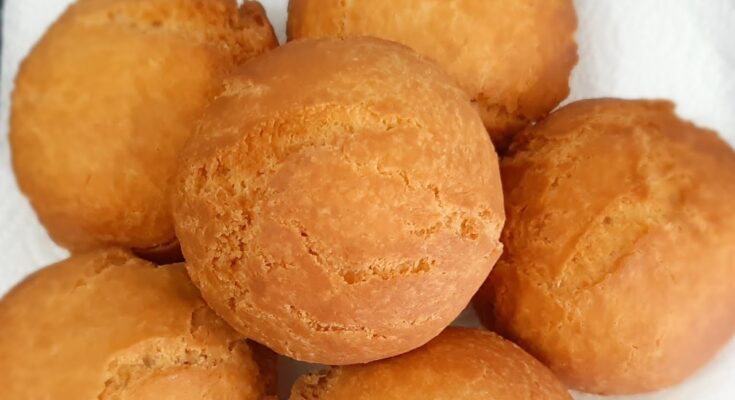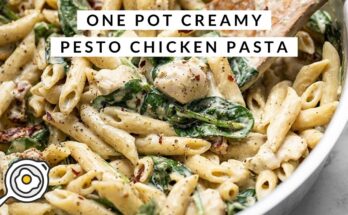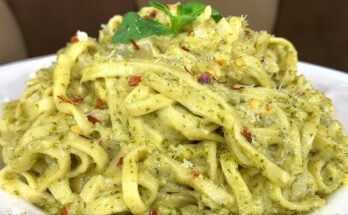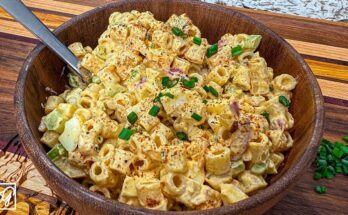Eggroll Recipe: Eggrolls are a beloved dish found in many Asian-American cuisines, often enjoyed as an appetizer or snack. These crispy rolls are typically filled with a savory mixture of meat, vegetables, and seasonings, then wrapped in a thin dough wrapper and deep-fried to golden perfection. The outer layer is crunchy and satisfying, while the inside bursts with flavor and texture. Whether served at a party, as part of dinner, or just as a treat, eggrolls never fail to impress. They’re not only delicious but also incredibly customizable, which makes them perfect for both beginners and experienced cooks.
The term “eggroll” can sometimes cause confusion—some people think there must be eggs inside, but in many recipes, the only “egg” element is in the dough used to make the wrappers. Regardless, they remain a staple in takeout menus and home kitchens alike, thanks to their irresistible crunch and tasty filling.
Brief History and Cultural Background
Eggrolls have an intriguing origin. While they are most associated with Chinese-American cuisine, their roots trace back to traditional Chinese spring rolls. Spring rolls were originally served during the Spring Festival in China and made with thin flour wrappers filled with fresh seasonal vegetables. When Chinese immigrants arrived in America, they adapted the recipe to suit local tastes and available ingredients. The result was a heartier roll with a thicker wrapper—what we now call the eggroll.
Over time, eggrolls became a fusion of East meets West, blending authentic Chinese flavors with American influences. The addition of cabbage, pork, and a thick, blistery wrapper is uniquely American-Chinese. Today, eggrolls have become a mainstay in many Asian restaurants across the U.S. and have even found their way into mainstream grocery store freezers and home kitchens.
Why Make Eggrolls at Home?
Making eggrolls at home might sound like a lot of work, but the effort is well worth it. First and foremost, you get to control every ingredient that goes into them, which means you can tailor the taste, spice level, and dietary content to your liking. Want to go vegetarian? No problem. Prefer them spicier? Go ahead and throw in some chili flakes.
Homemade eggrolls also tend to be fresher, crispier, and more flavorful than store-bought or takeout versions. Plus, they’re a fun family or group cooking project. Once you get the hang of wrapping and frying, you’ll find it’s not as intimidating as it might seem. You can make a large batch, freeze the extras, and always have a quick, delicious snack ready to fry up.
Ingredients Needed for Homemade Eggrolls
Essential Ingredients for Filling
A traditional eggroll filling is all about balance. You want a good mix of protein, vegetables, and seasoning. Here are the basics you’ll need:
- Protein: Ground pork is the most popular choice due to its rich flavor and moist texture. However, you can also use ground chicken, beef, shrimp, or even tofu.
- Vegetables: Finely shredded cabbage is the star of the show, usually accompanied by carrots, green onions, and bean sprouts. Some recipes include mushrooms for an umami boost.
- Seasoning: Garlic, ginger, soy sauce, sesame oil, and a dash of white pepper round out the flavor. These ingredients work together to create a savory, slightly tangy profile that’s classic in eggrolls.
Here’s a basic ingredient list:
- 1 lb ground pork or preferred protein
- 2 cups shredded cabbage
- 1/2 cup shredded carrots
- 3 green onions, chopped
- 2 cloves garlic, minced
- 1 tbsp soy sauce
- 1 tsp sesame oil
- Salt and pepper to taste
Feel free to adjust quantities based on your preferences or how many eggrolls you want to make.
Wrapper Options
The wrapper is what gives eggrolls their iconic crispy bite. You can find eggroll wrappers in the refrigerated section of most grocery stores or Asian markets. They are usually square-shaped and made with wheat flour, which makes them sturdier than spring roll wrappers.
Make sure you’re using eggroll wrappers and not spring roll wrappers—spring roll ones are thinner and more delicate, resulting in a different texture. If you’re adventurous, you can even make your own wrappers, but for convenience, store-bought ones work just fine and yield delicious results.
Optional Ingredients and Customizations
Eggrolls are endlessly customizable. Once you have the basic method down, you can experiment with flavors and ingredients. Here are some ideas:
- Add Noodles: Thin vermicelli rice noodles add an extra layer of texture.
- Spice It Up: Add chopped chilies or a dash of Sriracha to the filling for a spicy kick.
- Cheese Lover?: Some fusion recipes add shredded cheese to create “cheeseburger” eggrolls.
- Sweet Elements: Pineapple chunks or hoisin sauce can introduce a sweet contrast to the savory flavors.
You’re the chef here, so feel free to get creative and turn your eggrolls into a flavor-packed experience that suits your palate.
Preparing the Eggroll Filling
Cooking the Meat and Vegetables
The heart of every eggroll lies in its filling, and nailing this step is crucial to getting those restaurant-quality results at home. Start by heating a tablespoon of oil in a large skillet or wok over medium heat. Add your ground meat—pork, chicken, beef, or tofu—and break it up with a spatula. Cook it until it’s browned and cooked through, about 5–7 minutes.
Once the meat is ready, it’s time to add the vegetables. Toss in the minced garlic, shredded cabbage, carrots, and green onions. Stir everything together and sauté until the veggies are softened but still slightly crisp. This usually takes another 5 minutes. Don’t overcook them—you want them tender, not mushy.
Once the meat and vegetables are nicely combined, pour in the soy sauce and sesame oil. Give it a few tosses until everything is evenly coated. At this stage, you can also adjust the seasoning by adding more salt, pepper, or even a touch of sugar or vinegar for complexity.
This step is also where you can add in any of your favorite extras—mushrooms, bean sprouts, bamboo shoots, or even chopped shrimp. The key is to keep everything bite-sized and well-mixed.
Seasoning and Cooling the Filling
After cooking, transfer the filling mixture to a large bowl or plate and let it cool for at least 15–20 minutes. Why is this step so important? If you try to wrap eggrolls with hot filling, it can steam the wrapper and make it soggy, which means it won’t crisp up properly when cooked.
Letting the mixture cool also gives the flavors time to settle and blend. Some home cooks even prefer to make the filling a few hours ahead or overnight and refrigerate it. That way, the wrappers stay firm during the wrapping process, and the overall texture improves.
As the mixture cools, give it a taste test. This is your chance to tweak the flavors before wrapping begins. Want it spicier? Add some red pepper flakes or hot sauce. Need more zing? A squeeze of lime or a sprinkle of rice vinegar can brighten it up. Your taste buds are your guide here.
Wrapping the Eggrolls
Step-by-Step Wrapping Technique
Once your filling has cooled, it’s time for the fun part—wrapping! Start by laying an eggroll wrapper on a clean surface in a diamond shape, with one corner pointing toward you. Spoon about 2 tablespoons of filling onto the center of the wrapper. Don’t overfill—it can cause the roll to burst open during cooking.
Here’s the step-by-step technique:
- Fold the bottom corner up over the filling.
- Fold in the left and right corners toward the center, like you’re making an envelope.
- Roll the wrapper tightly toward the top corner, pressing gently to keep everything snug.
- Seal the top corner with a bit of water or a beaten egg. This acts like glue and keeps the roll from unraveling during frying.
If you’re new to wrapping, it might take a few tries to get the shape right—but once you get into a rhythm, you’ll be a pro in no time.
Tips to Prevent Leaks and Breaks
A few common mistakes can lead to leaking or splitting eggrolls, but they’re easy to avoid with some simple tips:
- Avoid overstuffing: It’s tempting to pack them full, but too much filling leads to tears and uneven cooking.
- Roll tightly: Loose rolls allow oil to seep in, making them greasy or fall apart.
- Use a proper seal: Water or beaten egg creates a sticky edge that prevents unrolling.
- Don’t let them dry out: Cover un-fried eggrolls with a damp cloth while you finish wrapping the batch. Dry wrappers can crack and become unusable.
You can also refrigerate the wrapped eggrolls for up to 4 hours before frying. Just be sure to cover them tightly with plastic wrap to prevent drying out.
Cooking the Eggrolls
Deep-Frying Instructions
Deep-frying is the traditional method for cooking eggrolls and delivers that unbeatable crispy texture. You’ll need a deep fryer or a heavy-bottomed pot filled with 2–3 inches of oil. Peanut oil or vegetable oil is ideal due to their high smoke points and neutral flavor.
Heat the oil to 350°F (175°C). Use a thermometer if you can—oil that’s too hot will burn the outside before the inside is heated through, and oil that’s too cool will result in soggy, greasy rolls.
Fry 3–4 eggrolls at a time, turning occasionally, until they’re golden brown and crispy—about 4–5 minutes per batch. Use a slotted spoon to remove them and drain on a paper towel-lined plate or wire rack. Give them a few minutes to cool before serving.
Air Fryer and Oven-Baking Alternatives
Looking for a healthier or lower-fat option? Good news—eggrolls can also be made in an air fryer or oven and still turn out delicious.
Air Fryer:
- Preheat to 375°F (190°C).
- Lightly brush or spray the eggrolls with oil.
- Arrange in a single layer (don’t overcrowd).
- Cook for 10–12 minutes, flipping halfway, until crispy and golden.
Oven-Baking:
- Preheat to 400°F (200°C).
- Place eggrolls on a baking sheet lined with parchment paper.
- Brush with oil and bake for 20–25 minutes, flipping once.
These methods are especially handy for big batches or make-ahead meals and still give you a satisfying crunch without deep-frying.
Serving Suggestions and Sauces
Popular Dipping Sauces
Eggrolls shine even brighter when paired with the right dipping sauce. Here are some favorites that enhance their flavor:
- Sweet and Sour Sauce: The tangy-sweet combo complements the savory filling perfectly.
- Soy Sauce: Simple and salty, it adds depth without overpowering the eggroll.
- Spicy Mustard: A little heat to balance the richness.
- Plum Sauce: Slightly sweet and fruity—especially good with pork or duck-filled rolls.
- Garlic Chili Oil: For those who like it hot, this sauce adds a fiery kick.
You can find many of these pre-made at the store, but they’re also easy to whip up at home with pantry staples.
Presentation Tips
If you’re serving eggrolls for a party or dinner, presentation matters. Here are a few tips:
- Slice eggrolls diagonally for a more elegant look.
- Serve on a platter with a dipping sauce in the center.
- Garnish with chopped green onions, sesame seeds, or even a sprinkle of chili flakes.
- Pair with a side of Asian slaw, rice, or noodles to round out the meal.
Whether it’s a casual snack or a plated appetizer, your homemade eggrolls deserve to look as good as they taste.
Storage and Reheating Tips
How to Store Leftovers Properly
Let’s say you’ve made a big batch of eggrolls—awesome! But what if you’ve got leftovers? Proper storage is the key to keeping them crispy and delicious even days later. First, make sure the eggrolls have cooled completely before storing. Placing hot eggrolls directly into the fridge can create condensation, which leads to soggy skins—nobody wants that.
For refrigeration, place the cooled eggrolls in an airtight container lined with a paper towel to absorb excess moisture. You can stack them, but add another layer of paper towel in between. Stored like this, they’ll stay fresh for up to 3 days.
Want to save them even longer? Go the freezer route. To freeze eggrolls:
- Arrange them in a single layer on a baking sheet and freeze until solid.
- Transfer the frozen eggrolls to a resealable freezer bag or airtight container.
- Label with the date—they’re best used within 1–2 months.
Whether raw or cooked, eggrolls freeze very well. Just remember to separate them so they don’t stick together.
Best Reheating Methods for Crispiness
Reheating eggrolls while maintaining that beloved crispy texture takes a little technique. Microwaves are fast but can make them chewy or soggy. Instead, use these methods:
Oven:
- Preheat to 375°F (190°C).
- Place eggrolls on a wire rack or baking sheet.
- Bake for 10–15 minutes, flipping halfway through.
Air Fryer:
- Preheat to 350°F (175°C).
- Cook for 6–8 minutes, shaking the basket halfway.
Skillet (for a quick crisp-up):
- Add a small amount of oil to a pan over medium heat.
- Heat eggrolls for 3–4 minutes per side until the wrapper is re-crisped.
Avoid microwaving unless you’re in a serious rush—otherwise, stick to dry heat methods to bring back that golden crunch.
FAQs about Eggroll Recipe
Can I make eggrolls ahead of time?
Yes! You can prep and wrap your eggrolls up to a day in advance. Just store them covered in the fridge and fry or bake them when ready. You can also freeze them raw or cooked for longer storage.
What’s the difference between eggrolls and spring rolls?
Eggrolls are typically made with a thicker, wheat-based wrapper and are deep-fried for a blistery, crunchy texture. Spring rolls use a thinner wrapper and are often filled with fresh veggies or rice noodles, and sometimes served uncooked or lightly fried.
Can I make eggrolls vegetarian?
Absolutely. Simply skip the meat and bulk up on shredded cabbage, carrots, mushrooms, tofu, and even glass noodles. Season well, and you’ve got a delicious meat-free version.
What oil is best for frying eggrolls?
Neutral oils with high smoke points like peanut oil, vegetable oil, or canola oil are ideal. Avoid olive oil or anything with a low smoke point, as it can burn quickly.
How do I keep eggrolls crispy?
The key is to serve them fresh and avoid steam. Don’t stack them immediately after frying; let them cool on a wire rack. If storing, reheat in the oven or air fryer instead of the microwave to restore their crispiness.
Conclusion
And there you have it—a complete, step-by-step guide to making eggrolls that are as good as your favorite takeout (if not better). From preparing a mouthwatering filling to achieving that irresistible crispy finish, each step of the process brings you closer to eggroll perfection.
Here are a few final tips to seal the deal:
- Taste your filling before wrapping—it’s easier to adjust flavors early.
- Don’t skimp on cooling the filling or sealing the wrappers tightly.
- Keep your oil at the right temperature for golden, non-greasy rolls.
- Try out different proteins and veggies to discover your personal favorite combo.
- And most importantly—have fun with it! Cooking eggrolls at home is a rewarding experience that gets easier (and tastier) every time.
Now that you know the secret to making incredible eggrolls at home, what are you waiting for? Get rolling and enjoy the crunchy, savory satisfaction of your homemade creations.



